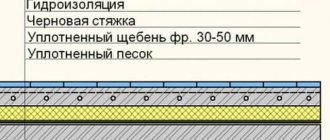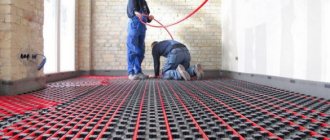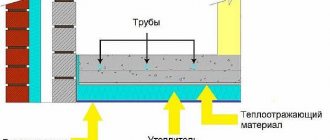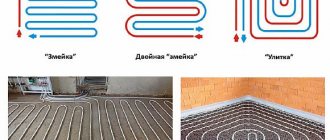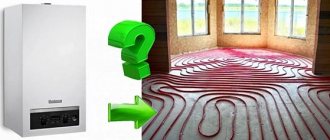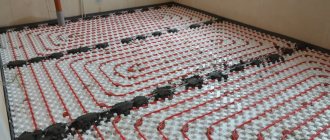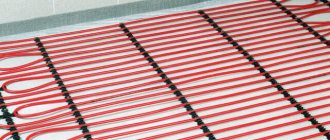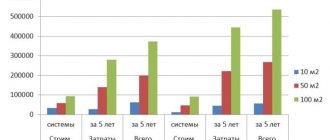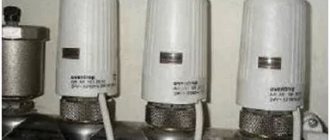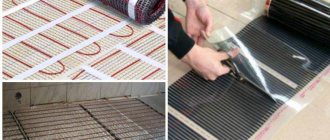In this article I will not tell you in detail how to make a heated floor with your own hands . Believe me, there are too many nuances, and possible mistakes are very expensive. Especially if we are talking about the water version. However, I will allow myself to introduce you to the technology, show what underfloor heating systems exist, what are their advantages and disadvantages. I am sure that if you have never encountered such tasks, you may not even be aware of some aspects. The result of “daring” experiments can be wasted money, damaged nerves, and wasted time. However, a properly made heated floor is a great thing. For the sake of convenience and comfort in the house, sometimes it makes sense to go to certain expenses and then walk barefoot on the floor for the rest of your life. And how happy your cat will be!!! In a word, let's see how it all works. Maybe you need such a thing, but you don’t know
Believe me, there are too many nuances, and possible mistakes are very expensive. Especially if we are talking about the water version. However, I will allow myself to introduce you to the technology, show what underfloor heating systems exist, what are their advantages and disadvantages. I am sure that if you have never encountered such tasks, you may not even be aware of some aspects. The result of “daring” experiments can be wasted money, damaged nerves, and wasted time. However, a properly made heated floor is a great thing. For the sake of convenience and comfort in the house, sometimes it makes sense to go to certain expenses and then walk barefoot on the floor for the rest of your life. And how happy your cat will be!!! In a word, let's see how it all works. Maybe you need such a thing, but you don’t know
Do you need heated floors?
My favorite thing to do after lunch is lie on the floor. You know how great it is! You stretch out, sometimes, on a hard surface, straighten your crooked bones and begin, like a boa constrictor, to slowly digest food. At home, having a warm floor is really convenient. But when I come to visit my parents and lay down on a regular floor, after a while I begin to feel some discomfort - concrete! Cold! Even on warm summer days the floor remains cool. You won't stay on it for long. You have to put something under your back.
But the house is beautiful! You lie as if on a beach by the sea. There the stones are heated by the sun, here a gas boiler works. It is he who drives warm water through plastic tubes and warms up the floor fairly evenly. It's especially great to feel a warm floor under your feet in winter. It used to be that if you took a walk around the neighborhood, your feet would freeze. But as soon as you come home, you feel as if you are walking on warm sand somewhere on the seashore.
But this is all, of course, lyrics. Sometimes you have to install warm floors in your home not on a whim, but because of a very real need. For example, a house stands on soil rich in groundwater. The foundation is a reinforced concrete slab (driving piles into such soil is a thankless task). The constant movement of water underground does not allow the soil to warm up to a certain depth. The cold of the underground river constantly cools the foundation, and with it the floor of the first floor. The feeling is like being in a dungeon. It’s unpleasant to walk without slippers even in summer, not to mention the colder season.
And if a family lives in such a cottage with a child, or two or three, whom you don’t feed with bread, let them sit on the floor and play? At this point you inevitably start to think and start Googling.
If you turn to the masters of their craft, they will tear off three skins. Moreover, they will start to scare you with lifetime extortionate electricity bills or the need to chisel a concrete floor to lay pipes. Maybe there is some option that is both inexpensive and easy? Surely there is! We are not in the 19th century... Yes, by the way, heated floors, so you know, this is not a modern technology. They were known in ancient Rome, some other countries and even in Russia. True, back then stove heating was used to heat the water. Nevertheless, there are scientifically proven facts confirming that heated floors are, as they say, “a well-forgotten old thing.”
As a rule, digging through the Internet ends with the same thing. We find out that heated floors for a private house or apartment can be made using two different technologies. Either water from a boiler , or electric from an outlet . In either case, different variations and even combinations are possible. Let's try to at least roughly understand which option may be right for you personally, taking into account the combination of advantages and disadvantages.
Specifics of arranging heated floors in frame buildings
Warm floors can be:
- Vodyany. Here water is used as the coolant circulating through the circuit.
- Electric. The heating elements are electrical cables or mats that emit heat in the infrared spectrum.
A frame house on stilts can be equipped with any of the above systems. However, the presence of a pile foundation makes some adjustments to the thermal insulation procedure and installation of a water heated floor. In this case, even at the stage of design measures, it is necessary to provide for the possibility of eliminating all cold zones by carefully sealing cracks and joints.
When deciding on the type of heated floor in a frame house on stilts, the following factors should be taken into account:
- Climatic conditions of the area.
- Geological specificity in the area of the house.
- Type of building structure used.
- Level of heat loss.
Electric heated floor. Film coating, heating cable, thermomat
An electric floor heating system has two undeniable advantages.
- It is quite easy to install it yourself,
- it can be used in an already finished apartment - there is no need to chisel the floor.
To simplify the idea very much, it is as follows. You measure the area of floors that need to be heated. This may not be the entire apartment, but, for example, only the children's room and bedroom. Moreover, heating the floor under cabinets and beds is also not so necessary. It will be enough if only the place where we walk is warm.
How much does underfloor heating cost?
Next we go to the store and buy electric heating elements. They are different. For example, infrared film is very convenient for installation. Relatively speaking, we lift the linoleum or laminate, first lay out the thermal insulation (such a silvery shiny material - polystyrene foam), then place the film in the right places on the floor, bring the wiring out from it so that you can “plug it into a socket.” After that, we lay out the laminate or linoleum again, turn it on - it works!
Infrared heated floors can be used with a thermostat, which allows you to choose the heating temperature and is capable of automatically maintaining the set room temperature. Moreover, advanced versions of thermostats can be programmed and it will itself lower the temperature (=energy consumption) when you are not at home or when you are sleeping, and increase it when you come home and start wandering from room to room. In principle - a very good solution.
In general, it’s like a scene from a movie about the future: you go up to the wall, press a couple of buttons on the regulator, and the room becomes warmer or cooler, depending on your desire. Each room can have its own temperature setting. Some people like warmer climates, others prefer cooler climates.
Everything would be fine, but this is a rather expensive solution. The film itself and, especially, the electricity it will constantly consume cost a lot.
Example:
The thermostat costs from 2 to 6 thousand rubles. If you have three rooms and a kitchen and you put one in each room, then the cost (we take the arithmetic average) is 16,000 rubles. These are just regulators, we haven’t gotten to the film yet.
The film itself, of course, also varies. If we take, for example, Caleo Line, then the cost of 6 square meters of film will be about 9,000 rubles:
Thus, if our children’s room has an area of, say, 12 meters, then we will need 2 sets, and, accordingly, about 18,000 rubles. Fortunately, this amount can be reduced a little. After all, it is absolutely not necessary to “sink” under a closet, bed or other furniture. I think 6 square meters would be enough for us.
If we add here 2 more rooms with an area of 14 and 18 square meters, conditionally dividing their area in half (there is also furniture there), then we get an additional cost for the film of 10,500 and 13,500 rubles, respectively (everything is rounded for ease of calculation).
Thus, to warm the floor only in the rooms we will need 33 thousand rubles for the film and 4 thousand for each regulator. The minimum is 37 thousand (there is only one regulator for the whole apartment - terribly inconvenient, but cheap).
In principle, the amount does not seem astronomical. Someone can buy all this literally tomorrow on the way from work, someone needs to save up a little money. Everyone's salary is different. But by installing an infrared heated floor, you can forget about the problem of cold in the apartment (if standard radiators can’t handle it), you can lie and sit on the floor, play with the children... in a word, the game is clearly worth the candle.
And everything would be fine, but now you have to cool your ardor by calculating your energy consumption. After all, you have to pay for everything. For electricity too. Let's estimate how much this pleasure will cost us.
Let's take January - the coldest month. You have to heat, as they say, to the fullest.
The average energy consumption of a heated floor can be calculated from the table above. Look at column 4. If we buy the largest film in area (6 sq. meters), then its consumption will be 0.78 kW per hour. Many people think so. However, this is not at all a meaning that is worth “dancing” with.
In fact, the average power consumption of film heated floors ranges from 46 to 220 W per square meter per hour.
Now we count again. We take the minimum values:
46 x 6 meters x 24 hours x 30 days = 198 kilowatts - then we multiply this by 5 rubles per kilowatt and get 990 rubles.
In other words, if your heated floor barely “smolders” for a whole month, then it will burn almost 1000 rubles worth of electricity.
If we have three rooms with the above parameters, it will be about 3-4 thousand rubles. per month.
In principle, this is also quite a tolerable amount. But... something tells me that you will still want to “turn up the temperature.” Well, it's true! What is the use of a heated floor that provides almost no heat at all?
Evil tongues (that is, the clients themselves who have already gotten themselves into trouble) are talking about slightly different figures. Some people get about 10-15 thousand rubles a month in winter for a 3-room apartment, others 25-30 thousand for a cottage. It is clear that to some these amounts do not seem fantastic. They'll pay and won't blink an eye. But what about those who have a more modest salary? I'm afraid something very, very bad could happen to many people when they receive their first electricity bill.
If you look at other types of electric heated floors, the situation does not change radically. Of course, you can install such a floor yourself, it seems safer, but huge electricity bills cancel out all the advantages.
It's true that sometimes people don't have much choice. For example, when buying a house, they believed the agent’s tales that gas would be piped here in the next month. Then it turns out that gas is not expected in this particular place in the near future, and if there is, then “for the pipe” you will have to pay through the nose. So we have to heat the house with electricity. What this entails has already been mentioned.
Water heated floor
This is a different approach. Here warm water acts as a heat carrier. It is heated in a boiler - electric or gas - and circulates through pipes embedded in the concrete floor screed. It is clear that such a pipe system can only be installed at the construction stage or, in extreme cases, finishing the house. Of course, there are extreme people who make grooves for laying pipes in a finished floor. However, this is the exception rather than the rule. If the main concrete floor screed is poured, it is more realistic to make a false floor, raised above the main one and lying on wooden blocks. Heating pipes can be placed in the resulting space.
The greatest benefit from a water heated floor can be obtained if you have a gas boiler. If there is no gas, then running an electric boiler to heat the water will simply be unreasonable. This combination embodies some of the negative aspects of each technology: inconvenient installation + constant high heating costs. If there is no gas and is not expected, then it is better not to mess with the pipes and do the usual electric heating described above. At least this floor is installed much faster and easier.
However, if there is already gas, or it will be “iron” in a year or two, then it is still worth thinking about pipes in the floor. To begin with, the system will operate from an electric boiler, and then, when the gas is turned on, it will be switched to a gas one. In all likelihood, this will be one of the happiest days of your life, because your monthly electricity bill will drop dramatically.
The cost of installing a water heated floor, subject to pouring a concrete screed, averages 500 rubles per square meter. If you have an apartment with an area of 60 square meters and decide to heat it all, then prepare an amount of 30,000 rubles (not counting the cost of equipment and materials). In principle, these are again not such unaffordable costs. This is why you should entrust the installation to real specialists, instead of “learning from your mistakes.”
Water or electric? Choosing heated floors for a country house
Choosing underfloor heating as a primary or secondary heating source has many benefits. It is not surprising that the number of people wishing to install such a heating system in their apartment or private house is constantly growing. However, when choosing a heated floor for their country house, many are faced with a dilemma - which heating mechanism to choose: water or electric? Without a doubt, both types of heating have both their advantages and disadvantages. Today we will get acquainted with each of them and tell you in which case an electric heated floor is suitable for you, and when you should give preference to a water one.
What is an electric heated floor?
What is a water heated floor?
Warm floors and choice of floor coverings
Comparative analysis of the advantages and disadvantages of warm and water floors
This floor is a cable heating system. Its heating sections are shielded single-core and double-core cables with two layers of insulation, as well as reliable connecting couplings.
Unlike a water system, in an electrical system, thermal energy is transferred directly to the floor covering and always warms the surface equally. In some cases, this imposes a number of restrictions on the use of heated floors in combination with various floor coverings and even with the arrangement of furniture.
By design, electric heated floors come in cable and film types. The cable version is mounted inside the tie, but this has virtually no effect on its thickness. The film version can be laid directly on top of the finished screed, only by first laying a thin layer of insulation made of polyethylene foam with a foil surface.
With the help of electric heated floors, you can easily heat small rooms that are not heated by the heating system: loggias, verandas, attics, open areas.
What is a water heated floor?
Related article: Fashion trends and new trends in interior design
This floor operates from a central water supply and, according to its operating principle, is a system of pipes through which hot water passes.
Installation of a water floor is considered more difficult, since to install it it is necessary to completely get rid of the old floor covering and screed. The heating structure itself takes up significant space. This is due to the need to reliably insulate the base of the floor. Only after this are pipes laid for water circulation, and a screed is made on top. As a result, a hydraulic heated floor requires a thickness of 5-7 cm. The insulation layer will vary from 4 to 15 cm. Since the hydraulic system is quite heavy, its installation requires special permits and approvals. Installing water floors is advisable in case of heating and connecting all rooms of an apartment or house at once.
Warm floors and choice of floor coverings
Related article: Interior of a country house in the Art Deco style
The underfloor heating system is not suitable for all floor coverings.
Since heating is carried out over the entire floor area, materials with a high thermal insulation value will prevent the flow of heat from heating elements and pipes into the room. As a result, significantly more energy will be required to heat the room. In this case, the elements will overheat, which will significantly reduce their service life. A hydraulic heated floor will withstand such conditions somewhat easier, but the efficiency will also decrease. Materials that prevent heat conduction include: cork, insulated linoleum, parquet and carpet.
A warm floor installed under parquet will cause it to dry out quickly, which will affect its appearance. The most effective are heated floors in combination with self-leveling floors and tiles. These materials allow heat to be transferred from the system elements to the surface and then to the room air as quickly as possible and without loss.
Under what kind of covering can a heated floor be installed?
Floor coverings that can be laid over underfloor heating include:
Uninsulated linoleum;
Laminate;
Thin parquet board;
Ceramic and tiles;
Self-leveling floors.
Video on the topic: House-chalet, technology. Combined house made of aerated concrete and wood.
Due to the characteristics of heat distribution, all of the above floor coverings are suitable for hydraulic heated floors. Electric floors are a little more complicated. Only cable systems can be used for tiles, ceramic tiles and self-leveling floors, because they are designed for pouring screed and mortar into the thickness.
However, if you still decide to use electric heaters under laminate or linoleum, the best option would be an infrared film heated floor. It is easily laid between layers of shock-absorbing heat insulator in the form of foamed polyethylene and directly with the laminate. In this option, the energy from the heating plates goes mostly to heating the surface and is not wasted on a thick layer of screed.
Comparative analysis of the advantages and disadvantages of warm and water floors
Related article: 5 options for designing a terrace in a country house
Cost . A complete set of electric underfloor heating costs approximately 2 times more than a water heated floor.
Cost of operation - if you compare heated floors according to this criterion, the advantage here will be on the side of the water heating heating system. The cost of heating the coolant is significantly lower, especially if a gas boiler is used for heating.
Cost of repairs - a comparison of electric and water heated floors, especially taking into account consumer reviews, shows that repair work related to cable damage is cheaper. You should also consider the consequences associated with a water pipe leak. If a leak occurs in an apartment in a multi-story building, the neighbors living below will have to be compensated for the repairs.
Cost of paperwork - in order to calculate the economic efficiency of underfloor heating, you need to take into account how much it will cost to obtain permission to operate a heating system. Electric floor heating does not require additional paperwork. To connect a water circuit, you will need to fill out a large number of papers, pay a state fee, etc. As a result, the cost of water floors (including paperwork) will be approximately equal to the price of a heating cable or mats.
Which floor is more economical? It all depends on where the heating system is planned to be installed. If in your own home, then installing a water circuit is more profitable. For an apartment, taking into account paperwork and installation of a thermostat, it is better to use a heating cable or mats.
Which floor is safer - electric or water? The undeniable advantage of a water heated floor over an electric one is its absolute safety. Although modern cable and film heating systems have a high degree of protection, there is still a possibility of electric shock during operation. To heat rooms with high humidity using a heating cable, it is necessary to use a special wire with a high degree of protection, which affects its cost.
What is more reliable – water heated floors or electric ones? There are certain advantages and disadvantages for each type of underfloor heating.
As for the electrical cable, quality products have a lifetime warranty. Even a relatively inexpensive wire will work for 20 years without problems. Most often, the temperature sensor or power regulator fails. If we talk about the water circuit, the pipe itself has a long service life, but the fittings fail within 10-15 years. The comparative characteristics of water and electric floors in this case are not in favor of the former. Even professional installation teams cannot always accurately determine the location of the leak, so repairs may require dismantling the screed.
Which heats better and is more economical?
It is impossible to say for sure which floors are warmer. Properly installed and used as intended, they all do their job perfectly. The same applies to the issue of cost. It is possible to install electric heated floors for the entire house with a smaller budget than a solution with laying water supply pipes would require. However, subsequently there will be less spending on heating the house, especially with constant use of the system.
On the other hand, it is absolutely unreasonable to install a water-heated floor separately on a loggia or for a bathroom. It is cheaper and easier to install an electric one. It is better suited for quickly warming up the floor surface when necessary.
Let's take a look at the technology for installing heated floors just for fun.
If you look at this photo, you can roughly imagine what will be required to lay the pipes:
If you go from the bottom up, then on the concrete floor slabs there is a heat insulator - a shiny material - extruded polystyrene foam. Don't be put off by the name; This kind of thing is sold in all construction supermarkets and even in hardware stores. It has very low thermal conductivity and sufficient mechanical strength. If we don’t put it in, part of the heat will go into the foundation, which we have absolutely no need to heat.
On top of the heat insulator we see a metal reinforcement grid. It will not strengthen the concrete screed, it is just convenient to attach pipes to it. The grate is attached to the floor so that the entire structure does not move from side to side:
The only thing that is not shown in this photo is the wall damper tape. It prevents contact between the warm floor screed and the cold wall.
Next, pipe laying begins. This is the most responsible process. The fact is that the tube should have only two connections and those with the distribution comb next to the boiler. Otherwise, it should be a solid loop, with a total length of 60 - 100 meters (depending on thickness). The tube itself is quite dense. It must be bent very carefully to prevent creases.
Many novice craftsmen make the same mistake, which greatly complicates pipe laying or even makes it impossible. Look at the tube roll:
The peculiarity is that the tube cannot simply be removed from the top, ring by ring. At the same time, it twists, creating tension that will greatly interfere with work. The coil must be “unwound”, that is, it must be twisted like a reel.
Another "ambush". Before starting work, you need to know exactly what length the loop you are installing will have. There are special computer programs for calculations. If oh, then at best you will have to cut off the excess unused ends, which you can only throw away. In the worst case, the tube may not be enough, and expanding it is extremely undesirable.
Of course, there are special connectors for this - fittings:
However, it is always worth remembering that there are no absolutely reliable connections. If such a thing “leaks”, you will have to chisel the floor. Do you need this? Therefore, you should very carefully calculate the length of the loop so that it is enough from the inlet to the outlet of the distribution manifold - the comb.
According to the methods of laying out the loops there are “snakes” and “snails”. It is easier to lay out the snake, but in this case there will be a clear temperature difference at different ends of the room. Where the circuit begins will be warm, as you move towards the opposite wall the floor will become colder. The difference can be from 5 to 10 degrees.
The snail is better in this regard. Here the temperature decrease goes from the walls to the middle of the room and is not felt so strongly. It is more difficult to lay out a snail, but this is exactly the case when it is better to do it properly once than to curse yourself for the rest of your life for being lazy.
All ends of the red tubes from all heating circuits “meet” near the distribution manifold:
Please note that the return pipes (through which cold waste water returns to the boiler) are covered in a thermal insulation “jacket”. This is done so that they do not cool the hot water that has just left the boiler and goes through adjacent pipes to heat the rooms.
Blue control knobs can be seen on the distribution manifold. When the system is installed, we will use them to balance the circuits.
It usually goes without saying that different circuits go to different rooms of the floor. This is convenient because you can adjust the heating in each room separately. However, it is usually not possible to make all the loops equally long. As a result, we get several loops of different lengths and, accordingly, with different hydraulic resistance.
It is not surprising that the main coolant flow, choosing the path with the least resistance, will rush along the shortest circuit. The room where it is installed will have the warmest floor in the entire house. In the longest circuit, the water will flow slower, so problems with heat removal and, accordingly, heating the floor of the corresponding room will be ensured.
A natural task arises - to deceive the coolant by convincing it that all loops in the system are the same length. This is achieved by analyzing the position of the flow meters and correspondingly adjusting the position of the “blue handles”:
The procedure for balancing circuits is quite ornate and complex to describe in this article. In any case, real specialists can complete it with an “A”. The main thing then is not to “touch anything” unnecessarily 
In order for water to circulate through the system, we need a water pump. It is connected to the place in the “pipe” where the already cooled waste water arrives.
On the left side of the pump there is a pumping speed regulator. The temperature of the heated floor throughout the house depends on it. They wanted to make it warmer - they started the pump faster. At the same time, the boiler itself continues to work with the same intensity. They wanted to make it cooler - they reduced the pumping speed.
Then the circuits are filled with water from the water supply. If the water quality is low, you should use a filter. It is necessary to rinse all the circuits of the heated floor so that there is no dirt, technological lubricant or chips left in them. The water outlet is directed to the sewer. It is advisable that the connected drain tube be transparent - this makes it easier to monitor the amount of water bubbles and dirt.
After each circuit has been washed (they should be washed separately), it is necessary to inspect all circuits. If leaks are detected, they must be eliminated. If none are found, the crimping .
Using a special pressure test pump, a pressure of 6 atmospheres is created in the system. This is twice the normal operating value. All circuits and connections are inspected again (ideally, connections should only be on the manifold - comb). Half an hour later - re-examination. If leaks are detected, they must be repaired after releasing the pressure.
If no leaks are found, then the system is left under a pressure of 6 atmospheres for a day. If in 24 hours the pressure in the system has dropped by no more than 1.5 atmospheres, the system can be considered working.
Please note: when pressure is applied, the tubes will tend to straighten. They may even rip off the mounting brackets. They must be carefully installed in their original places and reinforced with additional ones.
Next, the concrete screed is poured . This should occur with a filled floor heating system under operating pressure. It is highly advisable to align the screed according to the beacons:
It's quite a dirty job. Many people are intimidated by the need to tinker with cement mortar and are inclined to dry install electric heated floors. We have already discussed how this could turn out in the future. Again, this is the same case when it is better to “take off like a pig” once, but then not pay through the nose for electric heating. Look at these pipes one last time. They will most likely never be clean or see sunlight again:
However, everything in the world comes to an end. The concrete hardens, then the screed is filled with a finishing self-leveling mortar and we have a finished heated floor.
Now you can lay linoleum or other coverings on it. Please note: some types of laminate or parquet are not intended for use on heated floors. When choosing a coating, check that the packaging has the appropriate symbol:
Types of materials and their description
Popular thermal insulation for underfloor heating:
- Styrofoam;
- Extruded polystyrene foam;
- Mineral wool;
- Penofol;
- Heat-insulating mounting mats for heated floors.
Penofol is a simple insulation option for underfloor heating for houses with a warm basement or apartments
Option 1 - polystyrene foam
The most popular option due to the following advantages:
- Availability . The material can be purchased at almost any hardware store;
- Cheap . The price per square meter is from 100 rubles per square meter;
The material is sold in all construction stores and is inexpensive - these are the main advantages of polystyrene foam
- Large range of products . You can purchase material with a density from 15 to 35 kg/m3 and a thickness from 20 to 200 mm. For use on the floor, I advise choosing options with a density of 20 kg and a thickness of 30 mm or more;
You can choose the optimal foam thickness depending on what level of insulation is needed
- Versatility . The material is suitable for water, infrared and electric heated floors.
This option also has disadvantages:
- Low strength of the material . With high loads on the floor covering, the surface may be pressed. To avoid this, it is necessary to make a screed at least 6 cm thick;
- Inconvenient installation. It is difficult to tightly connect the sheets with your own hands, so the joints need to be filled with polyurethane foam or the sheets must be fixed to the surface.
The floor insulation process looks like this:
| Illustration | Description of the stage |
| Foam plastic is laid on the floor . The material can be laid without preparation on a concrete screed, slabs or rough wooden flooring. The most important thing is to place the sheets tightly so that there are no gaps between them. | |
| The elements are fixed with dowels . Special mushrooms are used to attach thermal insulation. All cracks are filled with cement mortar or foam. | |
| The film is being laid. The process is simple:
| |
| For infrared systems, foil is used . Reflective material can be used for other types of flooring, but it is not necessary. Penofol is often used instead of foil; it creates a reflective surface and makes the surface even warmer. | |
| A warm floor is laid on top of the insulated surface . It all depends on the type of construction. The surface is prepared with high quality and is suitable for any system. |
Option 2 - extruded polystyrene foam boards
Extruded polystyrene foam or, as it is also called, Penoplex, is an improved version of polystyrene foam. Its main advantages are:
- High thermal insulation performance . Penoplex is 40% warmer than conventional polystyrene foam, which allows the use of thinner elements for insulation;
Penoplex is a material with high thermal insulation properties, which makes it one of the best materials for insulating the surface under a heated floor.
- High strength . Of all the thermal insulation materials that I talk about in this review, this is the hardest and most durable. Therefore, Penoplex is ideal for rooms with high floor loads;
- Convenient connection system . The presence of grooves at the ends allows the sheets to be joined very tightly. This increases the efficiency of insulation and simplifies the work; you just need to combine the elements until they stop;
The grooves are offset relative to each other, which allows sheets to be joined on all sides equally reliably
- Durability . The service life of the material is 50 years or more. Extruded polystyrene foam is not afraid of moisture, mold, and chemical influences.
One of the significant disadvantages can be identified: high cost. A square meter of insulation 5 cm thick will cost you 250-300 rubles.
Installation instructions are simple:
| Illustration | Description of the stage |
| Penoplex is laid on the floor . The sheets simply fit tightly together. The elements are trimmed along the edges, narrow areas can be laid in pieces, after which it is recommended to carefully fill all the cracks with polyurethane foam. | |
| A reinforcing mesh is placed . If you are laying insulation under a warm water floor, then you can use this option for carrying out the work. It is simple, because you need to lay a mesh, and you can immediately attach the heated floor pipes to it. It's convenient and reliable. | |
| You can lay reflective material under the reinforcing mesh . This option allows you to reflect heat into the room, so I recommend not saving and putting a layer of foil or Penofol on the surface. |
If you are laying an infrared floor, then the foil is laid not on top of Penoplex, but on top of the screed, after pouring the surface under the heating mats, this way the system will be much more efficient.
Option 3 - mineral wool slabs
This insulation option for an underfloor heating system has the following features:
- High quality insulation . Mineral wool has good thermal insulation characteristics and is excellent for structures in which complete insulation of a cold surface is of greatest importance;
High density mineral wool is used for the floor
- Compatibility with all materials . If polystyrene foam and extruded polystyrene foam are not very suitable for wood, then mineral wool is an excellent solution in all cases. For wooden floors, it is recommended to use mineral wool;
- Environmental friendliness . The material does not emit any harmful substances into the air, is not damaged by rodents and does not support combustion.
The disadvantages are:
- High price . For a square meter of high-quality mineral wool 5 cm thick you will have to pay around 250 rubles;
- Low moisture resistance . The material must be carefully protected from water, otherwise fungus may develop over time.
The workflow looks like this:
| Illustration | Description of the stage |
| The surface is waterproofed . Polyethylene film can be laid on the concrete surface. If you have a wooden base, then it is better to put a vapor-permeable membrane. The material should extend 10-15 cm onto the walls; the joints must be taped. | |
| Mineral wool is laid . The material is tightly located on the surface. When cutting pieces, make them a little larger than necessary, this will allow the elements to fit tightly together. Immediately lay a damper tape along the walls to create a deformation gap. | |
| If you have a wooden structure, lay mineral wool between the beams . The material may be below the sheathing or located flush with it. Subsequently, the surface is covered with moisture-resistant slabs and the heated floor system is laid on them. | |
| Foil is placed on top of the mineral wool . The material is placed with 10 cm overlaps at the joints and the joints must be glued with foil tape. This results in a continuous reflective surface that is suitable for both water and electric heated floors. |
Option 4 - Penofol
This material is different from all previous ones. Its main advantages are:
- Cheap . For a square meter of material 5 mm thick you will pay about 50 rubles;
- Lightness . 40 square meters of Penofol weigh only 8 kg. It can be laid on any structures without weighing them down;
- Efficiency . Foamed polyethylene has high thermal insulation characteristics. The reflector on the front side ensures heat retention inside the room. That is, it turns out that the foil on the heated floor is combined with insulation;
Penofol - a material based on foamed polyethylene with a reflector on the front side
- Selecting options . The material can have a thickness from 3 to 10 mm.
The disadvantages are:
- It is not worth using this option as a full-fledged heat insulator in the private sector;
- It is better to combine two materials, for example extruded polystyrene foam 3 cm thick and Penofol 5 mm thick. This is quite enough to create very high-quality insulation;
- The surface must be prepared for laying this material.
The workflow looks like this:
| Illustration | Description of the stage |
| Waterproofing material is laid on the floor . The film is glued at the seams and placed on the walls to a height of about 10 cm; the excess is easily cut off later. | |
| Penofol is laid on top of the film. It is positioned in the same way as the film. It is important to carefully straighten the material so that it lies without wrinkles and adjacent panels do not overlap each other. If you have already installed insulation and need foil under the heated floor to create a reflective effect, then I recommend using Penofol instead. Due to the polyethylene layer it is stronger and more durable. | |
| The joints are taped with special tape . This is metallized tape with foil, which allows you not only to hold Penofol together, but also to create a continuous reflective surface throughout the room. | |
| A heated floor system is laid on top of the insulation . It all depends on the option you choose. Next, the screed device is made. |
Beacons are placed on top of the structure and screed is poured. The minimum thickness of the mortar layer above the insulation elements is 30 mm, the maximum is 60 mm. This allows you to make the floor reliable and effectively transfer heat from the system to the room.
Option 5 - special thermal insulation mats for heated floors
This option has the following advantages:
- Convenience . The product is a sheet of extruded polystyrene foam, in the upper part of which there is a profile with grooves or bosses for laying underfloor heating pipes. The size of the recesses is made for a standard plastic pipe with a diameter of 16 mm, so installation work is done very quickly;
This is a special insulation for water floors, which greatly simplifies the installation process.
- Selecting options . The thickness of the insulating layer can be from 20 to 70 mm. The configuration of the upper part may also differ, although this is not a fundamental point;
- Fast installation process . The work takes little time due to the fact that you quickly and efficiently lay pipes, and then you can lay tiles or lay flooring without additional preparation. If desired, you can fill the screed; this is also quick and easy.
The tiles can be laid directly onto the mats, simply apply adhesive to fill any voids and lay down the ceramic
The disadvantage is the high cost; you will have to pay 300 rubles per square meter. But when you consider how much easier the process is, the cost is worth it.
The working process:
| Illustration | Description of the stage |
| The floor surface is leveled . For this, cement mortar is most often used. The fewer flaws there are, the easier it is to lay a flat floor with minimal time. If plywood or OSB boards (oriented strand board) will be laid over the mats, then pay special attention to leveling. | |
| The damper tape is being prepared . The roll unwinds, the protective layer on the adhesive strip is removed from the back, you don’t need to remove much, separate about a meter, then the film is removed as you lay it. | |
| The tape is glued to the walls around the perimeter . The material is carefully pressed against the surface, paying special attention to the corners. The tape is cut with a regular construction knife. | |
| The first row is laid along the wall . The photo clearly shows that at the junction there is a special protrusion that tightly connects the elements and does not allow them to move, providing a reliable and even base for the heated floor system. Docking is carried out carefully so as not to damage the connection. | |
| Laying is done over the entire surface . If you need to cut off a strip somewhere, it can be used on the other side; thanks to the connections, there is almost no waste left when using these mats. | |
| The pipe is being laid . It is simply guided along the line; it is most convenient to push it in by stepping lightly with your foot. | |
| The pipe is laid over the entire area . Thanks to the bosses, you can easily place the heated floor correctly and avoid bending the pipe. Next, the floor covering is laid or the screed is poured. |
If you do not need to insulate the floor under the heating system, you can use mats without a layer of insulation. With their help, installation will be much faster than on an unprepared surface.
Mats without insulation simplify installation and create a moisture-proof barrier when laying heated floors
Some numbers
Now let's look at some very average cost of heating a room with water heated floors using a gas boiler. Of course, this value can be easily disputed, since it is calculated based on a variety of initial data.
Remember, we tried to calculate the cost of heating a 12 square meter room using infrared film. If you forgot, I remind you that electricity costs amounted to about 1000 rubles. Of course, this is also a very approximate value.
Now we take the same room, but use a water-heated floor for heating. On average, based on the cost of gas, the amount is approximately 3-4 times less, that is, about 200-300 rubles. For heating the entire apartment it will cost 1000-2000 rubles, which is much cheaper than the option with electric heating.
It would be long and boring to talk about how this figure came about. Some may doubt it and they will be right. A lot depends on the characteristics of the premises itself, the cost of equipment, and communications.
One thing is absolutely clear - a water heated floor with a gas boiler “heats cheaper” than the same option with an electric one or all kinds of film-cable electric options.
Features: pros and cons
Features of heated floors, positive aspects:
- Create comfort and increase the temperature of the room;
- Suitable for various types of floor coverings;
- Indispensable for private homes;
- It is possible to install it yourself;
- Can be used for any energy source;
- No dust circulation, if the floors are not electric, then there are no electromagnetic fields and do not harm health;
- Saving money. Uniform distribution of heat throughout the room, controlling the same temperature.
Negative sides:
- Inability to create a large area of underfloor heating;
- Impossibility of sudden changes in coating temperature;
- Dependence on the power supply, in case of a power outage, the system stops working, in the case of an electric floor;
- Lack of air circulation, plus fogging of windows near the ceiling.
It is sometimes difficult to insulate a private house, so in addition to heating from radiators, it is necessary to insulate the walls and floor in various ways. Various types of heated floors are suitable for all types of rooms and any interior.
Varieties by type of heating elements:
- Cable,
- Thermomat,
- Film,
- Infrared film,
- Water ones, which will be discussed further.
3D Scheme
